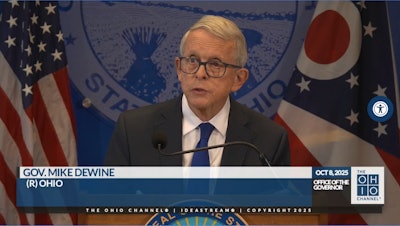
Ohio Gov. Mike DeWine took executive action on Oct. 8 to shut down hemp-derived cannabinoid product sales for at least 60 days, directing the Department of Agriculture and other state agencies to adopt emergency regulations.
As part of an executive order he issued following a 2:30 p.m. press conference on Wednesday, the governor declared a state of emergency in the absence of regulatory oversight to safeguard public health.
In the order, DeWine calls attention to delta-8 THC as well as product packaging that’s attractive to children, youth access without age-verification standards in place, and data from the Ohio Poison Centers showing a 52% uptick in 2024 in cases involving children 12 years and younger who were exposed to intoxicating cannabinoids.
Many of these cases stem from delta-8 THC, an intoxicating synthetic cannabinoid that’s often converted in a lab from nonintoxicating CBD that’s derived from hemp.
DeWine also pointed out that, unlike licensed and regulated adult-use cannabis sales, intoxicating hemp products are not required to be lab tested for potency, heavy metals, mold, pesticides and residual solvents, or other potentially harmful constituents.
Instead of sitting back and waiting for legislative action on a plethora of proposals in the Ohio General Assembly, DeWine ordered Ohio retailers – including smoke shops, gas stations and convenience stores – that carry hemp-derived cannabinoid products to:
- Remove these products from public display;
- Stop selling or offering to sell these products; and
- Segregate these products from other merchandise and hold them, or a portion of them, for disposition by law enforcement officers or officials from the Department of Agriculture.
The order for this state of emergency will last for at least 60 days, but the governor could extend the emergency for an additional 30 days. And it could be extended longer under a concurrent resolution adopted by the Ohio General Assembly.
“I … hereby order and direct that there is a reasonable basis to believe that intoxicating hemp … and intoxicating hemp products have been adulterated and that further sale or use of intoxicating hemp and intoxicating hemp products present a threat to public health and safety,” he wrote in the executive order.
DeWine’s pursuit to crack down on intoxicating hemp products comes after California Gov. Gavin Newsom and Texas Gov. Greg Abbott took similar approaches in September 2024 and September 2025, respectively. Illinois Gov. JB Pritzker is looking to do the same.
While hemp, by definition, is a nonintoxicating cannabis plant that contains no more than 0.3% delta-9 THC during a pre-harvest field test, the popularity of intoxicating gummies, beverages and other consumable hemp products took off in the aftermath of the 2018 Farm Bill, which federally legalized commercial hemp cultivation in the U.S.
While the 2018 Farm Bill regulates hemp as an agricultural commodity, the U.S. Food and Drug Administration’s inaction on federally regulating consumable hemp products has left states to rein in individual marketplaces that have proliferated as an unintended consequence.
RELATED: Federal Court Rules Virginia’s Total THC Hemp Regulations Supersede 2018 Farm Bill
Without hemp-derived cannabinoid product regulations in Ohio, children can legally purchase intoxicating products in packaging that sometimes resembles popular candy. While some companies may independently test their hemp products through a third-party lab and provide a certificate of analysis, there’s no state law requiring them to do so.
Through his executive order, DeWine indicated that he intends to redefine “hemp” and “hemp products” to exclude intoxicating hemp in the state’s administrative code.
The governor also tasked the Ohio Department of Agriculture with adopting rules regarding standards and procedures for the regulation of hemp cultivation and processing moving forward.
Under the Ohio Revised Code, state agencies allow government agencies to bypass normal rulemaking procedures and immediately adopt, amend or rescind regulations for up to 120 days when an emergency exists. This often spurs legislative action.


























